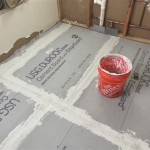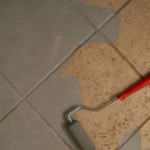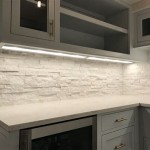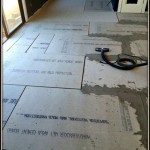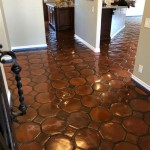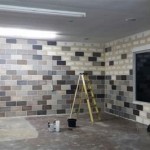Gorgeous Concrete Tile Backsplash Tiles: A Modern Design Statement
Concrete tiles have emerged as a versatile and aesthetically appealing material in contemporary interior design. Their raw, industrial aesthetic, combined with their durability and adaptability, makes them a popular choice for various applications, including backsplash tiles. A concrete tile backsplash can dramatically transform a kitchen or bathroom, lending a sophisticated and modern touch while offering a practical and long-lasting surface.
The appeal of concrete lies in its inherent characteristics. It's a manufactured stone, meaning it can be molded and shaped during production, allowing for a wide range of sizes, shapes, textures, and colors. This design flexibility distinguishes it from natural stone, which is limited by its natural formation. Concrete tiles can mimic the look of natural stone, brick, or even wood, further expanding their design potential. Furthermore, concrete can be pigmented, stained, or polished to create unique visual effects. Micro concrete, in particular, offers an exceptionally smooth and refined surface.
Concrete tile backsplashes offer a significant design statement. They introduce a touch of urban chic and sophistication, blending well with various design styles, from minimalist and industrial to modern farmhouse and even eclectic. The inherent texture and variation in color within concrete tiles add depth and visual interest, preventing the backsplash from appearing flat or sterile. The cool, neutral tones of concrete also provide a neutral backdrop that allows other design elements, such as cabinetry, countertops, and hardware, to take center stage. This allows for considerable creativity in the overall design.
Durability and Practicality of Concrete Backsplash Tiles
Beyond aesthetics, concrete tile backsplashes are renowned for their durability and longevity. Concrete is a strong and resilient material capable of withstanding the demands of daily use in a kitchen or bathroom. It is resistant to scratches, chips, and cracks, ensuring that the backsplash remains in pristine condition for years to come. This inherent strength significantly reduces the need for frequent replacements or repairs, making it a cost-effective choice in the long run.
Furthermore, concrete is relatively easy to maintain. While it is porous, concrete tiles used for backsplashes are typically sealed to prevent staining and water damage. A properly sealed concrete backsplash can be easily cleaned with a damp cloth and mild detergent, eliminating the need for harsh chemicals or specialized cleaning products. Regular resealing, typically every one to three years depending on the sealant used and the level of usage, will further enhance its stain resistance and longevity, maintaining its pristine appearance.
The moisture resistance of sealed concrete is a critical factor in its suitability for backsplash applications, especially in areas prone to water exposure, such as behind sinks and cooktops. The sealant acts as a barrier, preventing water from penetrating the concrete and causing potential damage or discoloration. The selection of an appropriate sealant is crucial for maintaining the integrity and appearance of the concrete tile backsplash over time. Some sealants offer enhanced stain resistance, while others provide a more matte or glossy finish, allowing for customization to suit the overall design aesthetic.
Another advantage of concrete is its thermal mass. While not as significant in a thin tile format, concrete has the ability to absorb and retain heat. This characteristic can subtly contribute to maintaining a consistent temperature in the kitchen, particularly if the backsplash is located near a heat source like an oven or stove. This property can lead to a more comfortable and energy-efficient kitchen environment.
Design Versatility and Aesthetic Applications
The design versatility of concrete tiles is a key factor in their growing popularity for backsplash applications. They are available in a wide range of sizes, shapes, and colors, providing endless possibilities for creating unique and personalized designs. Large-format concrete tiles can create a seamless and modern look, while smaller tiles can be arranged in intricate patterns to add visual interest. Geometric shapes, such as hexagons, squares, and triangles, offer a contemporary edge, while more organic shapes can lend a rustic or artistic feel.
The color palette of concrete tiles extends beyond the traditional gray. Pigments can be added to the concrete mix to create a wide array of colors, from earthy tones to bold and vibrant hues. Stains can also be applied to the surface of the tiles to achieve a specific color or effect. The ability to customize the color of concrete tiles allows for seamless integration with the existing color scheme of the kitchen or bathroom. Furthermore, the natural variations in color within concrete tiles create a unique and organic look that adds depth and character to the backsplash.
Concrete tiles can also be textured to create different visual effects. Smooth, polished concrete tiles offer a sleek and modern look, while textured tiles add a tactile dimension to the backsplash. The texture can range from subtle indentations to more pronounced patterns, creating a visually stimulating surface. Some concrete tiles even mimic the look of natural stone or brick, adding a rustic or industrial touch to the space. The choice of texture depends on the desired aesthetic and the overall design style of the room.
The grout lines between concrete tiles also play a significant role in the overall design. The color and width of the grout can either blend in with the tiles for a seamless look or contrast with the tiles to create a more defined pattern. Dark grout lines can add a dramatic touch, while lighter grout lines can create a more subtle and airy feel. The choice of grout color and width should be carefully considered to achieve the desired aesthetic.
Installation Considerations for Concrete Tile Backsplashes
Proper installation is crucial for ensuring the longevity and aesthetic appeal of a concrete tile backsplash. Concrete tiles, while durable, can be heavy and require careful handling during installation. A level and stable substrate is essential for preventing cracking or shifting over time. The substrate should be properly prepared by cleaning and leveling the surface to ensure a strong bond between the tiles and the adhesive.
The choice of adhesive is also critical for a successful installation. A high-quality thin-set mortar specifically designed for concrete tiles is recommended. The mortar should be applied evenly and consistently to ensure proper adhesion. The tiles should be carefully positioned and pressed firmly into the mortar, ensuring that they are level and aligned. Spacers should be used to maintain consistent grout lines between the tiles.
Grouting is the final step in the installation process. A high-quality grout specifically designed for use with concrete tiles is recommended. The grout should be applied evenly and thoroughly, filling all the grout lines completely. Excess grout should be removed with a damp sponge before it hardens. After the grout has cured, the backsplash should be sealed with a penetrating sealant to protect it from staining and water damage. Regular resealing is recommended to maintain the integrity of the sealant.
It is generally recommended to hire a professional tile installer experienced in working with concrete tiles. An experienced installer will have the knowledge and skills necessary to properly prepare the substrate, select the appropriate adhesive and grout, and install the tiles with precision and care. While DIY installation is possible, it is important to have the necessary tools and experience to ensure a successful outcome. Consulting with a professional before starting the installation can help to avoid costly mistakes and ensure that the concrete tile backsplash looks beautiful and lasts for years to come.
In conclusion, concrete tile backsplashes offer a compelling combination of aesthetic appeal, durability, and design versatility. Their ability to seamlessly blend with various design styles, combined with their low-maintenance characteristics, makes them a popular choice for modern kitchens and bathrooms. With careful planning and proper installation, a concrete tile backsplash can transform a space into a stylish and functional environment.

Kitchen Cement Tiles And Concrete Wall Granada Tile

Get The Look Maison21s Mays Hex Cement Tile Backsplash Granada Blog Ideas Tips And More

Backsplash Tiles Cement And Concrete For Kitchen Granada Tile

Kitchen Cement Tiles And Concrete Wall Granada Tile

Kitchen Cement Tiles And Concrete Wall Granada Tile

Diy Concrete Tile Backsplash Zellige Inspired Lily Ardor

5 Amazingly Beautiful Mediterranean Tile Backsplashes

Design A Gorgeous Kitchen Tile Backsplash With The Olvera Collection Granada Cement Blog Ideas Tips And More

Kitchen Backsplash Cement Tile Blog

Diy Concrete Tile Backsplash Zellige Inspired Lily Ardor
Related Posts


